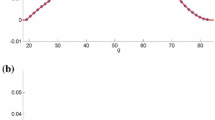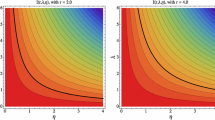Abstract
Conservation Biologists have found that demographic stochasticity causes the mean time to extinction to increase exponentially with population size. This has proved helpful in analyses determining extinction times and characterizing the pathway to extinction. The aim of this investigation is to explore the possible interactions between environmental/demographic noises and the scaling effect of the mean population size with its variance, which is expected to follow Taylor’s power law relationship. We showed that the combined effects of environmental/demographic noises and the scaling of population size variability interact with the population dynamics and affect the mean time to extinction.

Similar content being viewed by others
Abbreviations
- CV:
-
Coefficient of variation
- F d :
-
Size of the fluctuations in population size caused by demographic processes
- F e :
-
Size of the fluctuations in population size caused by environmental processes
- HM:
-
Harmonic mean
- K :
-
Constant
- log :
-
Logarithm
- N E :
-
Effective population size
- p:
-
Phase between sinusoidal fluctuations
- r:
-
Instantaneous growth rate
- SD:
-
Standard deviation
- β:
-
Scaling coefficient
- ρ :
-
Correlation
- \( \bar{\mu } \) :
-
Aritmetic mean
- \( \bar{\mu }_{pop} \) :
-
Arithmetic mean of population size
- σ 2tot :
-
Variance of the population size in the presence of environmental noise
- σ2 :
-
Variance of the population size in absence of environmental noise
- σ 2e :
-
Demographic noise
- σ 2e :
-
Environmental noise
- ρ(σσe):
-
Covariance between the environmental noise and the population fluctuation
References
Ballantyne F, Kerkhoff AJ (2007) The observed range for temporal mean-variance scaling exponents can be explained by reproductive correlation. Oikos 116:174–180
Boyce MS, Haridas CV, Lee CT, NCEAS (2006) Stochastic Demography Working Group: demography in an increasing variable world. Trend Ecol Evol 21:141–148
Braumann CA (2008) Growth and extinction of populations in randomly varying environments. Comput Math Appl 56:631–644
Drake JM, Lodge DM (2004) Effects of environmental variability on extinction and establishment. Ecol Lett 7:26–30
Engen S, Lande R, Sæther B-E (2002) The spatial scale of population fluctuations and quasi-extinction risk. Am Nat 160:439–451
Fieberg J, Ellner SP (2000) When is it meaningful to estimate an extinction probability? Ecology 81:2040–2047
Foley P (1994) Predicting extinction times from environmental stochasticity and carrying-capacity. Conserv Biol 8:124–137
Grimm V, Wissel C (2004) The intrinsic mean time to extinction: a unifying approach to analysing persistence and viability of populations. Oikos 105:501–511
Guichard F (2005) Interaction strength and extinction risk in a metacommunity. Proc R Soc Lond Ser B Biol Sci 272:1571–1576
Hakoyama H, Iwasa Y (2005) Extinction risk of a meta-population: aggregation approach. J Theor Biol 232:203–216
Kohlmann SG, Schmidt GA, Garcelon DK (2005) A population viability analysis for the island fox on Santa Catalina Island, California. Ecol Model 183:77–94
Lande R (1993) Risks of population extinction from demographic and environmental stochasticity and random catastrophes. Am Nat 142:911–927
Melbourne BA, Hastings A (2008) Extinction risk depends strongly on factors contributing to stochasticity. Nature 454:100–103
Møller AP, Garamszegi LZ, Spottiswoode CN (2008) Genetic similarity, distribution range and sexual selection. J Evol Biol 21:213–225
Parmesan C (2006) Ecological and evolutionary responses to recent climate change. Annu Rev Ecol Evol Syst 37:637–669
Peña TS, Johst K, Grimm V, Arntz W, Tarazona J (2005) Population dynamics of a polychaete during three El Nino events: disentangling biotic and abiotic factors. Oikos 111:253–258
Pertoldi C, Bach LA, Barker JSF, Lundberg P, Loeschcke V (2007) The consequences of the variance-mean rescaling effect on effective population size. Oikos 116:769–774
Pertoldi C, Bach LA, Loeschcke V (2008) On the brink between extinction and persistence. Biol Direct 3:47
Pimm S (1993) Life on an intermittent edge. Trend Ecol Evol 8:45–46
Sæther BE, Engen S (2003) Routes to extinction. In: Blackburn T, Gaston K (eds) Macroecology. Blackwell Publishing, Oxford, pp 218–236
Schodelbauerova I, Tremblay RL, Kindlmann P (2010) Prediction vs. reality: can a PVA model predict population persistence 13 years later? Biodivers Conserv 19:637–650
Taylor LR, Woiwood IP, Perry JN (1978) The density-dependence of spatial behaviour and the rarity of randomness. J Anim Ecol 47:383–406
Turchin P (1999) Population regulation: a synthetic view. Oikos 84:153–159
Wright S (1931) Evolution in Mendelian populations. Genetics 16:97–159
Acknowledgments
This study has been partly supported by the Danish Natural Science Research Council for financial support to CP (grant number: #11-103926, #09-065999 and 95095995) and the Carlsberg Foundation (grant number 2011-01-0059). We thank three anonymous Reviewers and the Associate Editor Lia Hemerik, for invaluable suggestions and help.
Author information
Authors and Affiliations
Corresponding author
Rights and permissions
About this article
Cite this article
Pertoldi, C., Faurby, S. Consequences of Environmental Fluctuations on Taylor’s Power Law and Implications for the Dynamics and Persistence of Populations. Acta Biotheor 61, 173–180 (2013). https://doi.org/10.1007/s10441-012-9167-z
Received:
Accepted:
Published:
Issue Date:
DOI: https://doi.org/10.1007/s10441-012-9167-z




